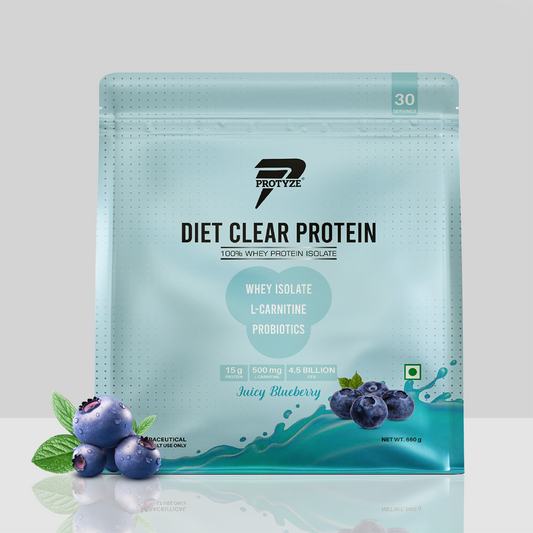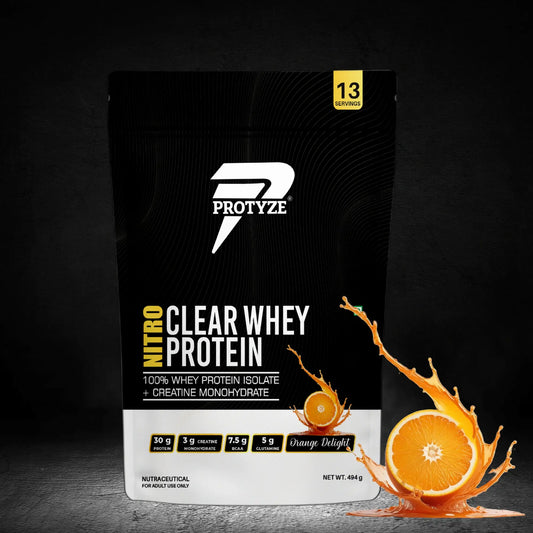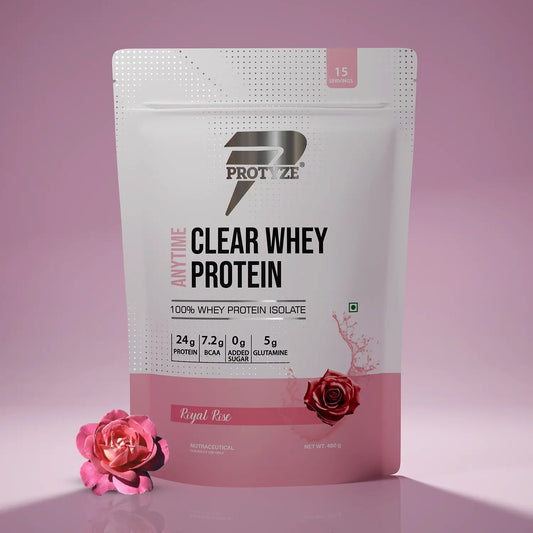Clear whey protein has revolutionized the protein supplement market, offering a light, refreshing alternative to traditional creamy protein shakes. Unlike standard whey, clear whey delivers a juice-like consistency, high protein content, and minimal calories, making it a favorite for fitness enthusiasts seeking muscle support without the heaviness.
This blog explores how clear whey is prepared, its advantages, and how it fits into a healthy lifestyle. We’ll also highlight Protyze Diet Clear Whey, a low-calorie, probiotic-enhanced clear whey, to illustrate its role in nutrition.
What is Clear Whey Protein?
Clear whey protein is a highly purified form of whey protein isolate, processed to remove most fats, carbs, and lactose, resulting in a transparent, juice-like drink when mixed with water. It typically contains 15-30g protein per serving, with minimal calories (~60-100 kcal), making it ideal for muscle recovery, weight management, and hydration.
Unlike traditional whey protein, which creates a milky shake, clear whey’s light texture and fruity flavors (e.g., mango, berry) appeal to those seeking a refreshing post-workout or daily protein boost. Its high purity and digestibility set it apart, catering to fitness goals and sensitive stomachs.
Key Features of Clear Whey
- High Protein: Delivers 15-30g protein per serving for muscle repair.
- Low-Calorie: Minimal fats and carbs, perfect for weight control.
- Clear Texture: Juice-like consistency, refreshing and easy to drink.
- Digestibility: Low lactose content, suitable for lactose-sensitive individuals.
The Process of Making Clear Whey Protein
Creating clear whey protein involves a meticulous, multi-step process that transforms milk into a pure, transparent protein powder. Below, we outline the key stages, from raw milk to the final product, emphasizing the science behind its clarity and quality.
1. Milk Collection and Separation
The journey begins with fresh cow’s milk, the primary source of whey protein. Milk contains two main proteins: casein (~80%) and whey (~20%). To isolate whey, milk undergoes centrifugation, a process that spins milk at high speeds to separate its components based on density. This yields:
- Cream: High in fat, used for butter or cheese.
- Skim Milk: Low-fat liquid containing casein and whey.
The skim milk is then processed further to extract whey, typically during cheese production, ensuring a sustainable use of milk components.
Why It Matters
- Separation ensures whey is isolated efficiently, setting the stage for purification.
Output
- Liquid whey, rich in proteins but mixed with lactose, fats, and minerals.
2. Whey Extraction During Cheese Production
Whey is a byproduct of cheese-making. Skim milk is heated and mixed with enzymes (e.g., rennet) or acids to coagulate casein, forming curds (used for cheese) and leaving behind liquid whey. This liquid whey is collected and filtered to remove residual curds, bacteria, or impurities, resulting in a protein-rich solution ready for further processing.
Why It Matters
- This step isolates whey while maintaining its nutritional integrity.
Output
- Raw liquid whey, cloudy and containing whey proteins, lactose, and trace fats.
3. Microfiltration and Ultrafiltration
To create clear whey, the liquid whey undergoes microfiltration and ultrafiltration, advanced filtration techniques that purify the protein.
- Microfiltration: Uses fine membranes to remove larger particles, bacteria, and some fats, producing a cleaner whey solution.
- Ultrafiltration: Further concentrates the whey proteins by filtering out lactose, minerals, and smaller impurities, increasing protein content to ~90% or higher.
These processes yield best whey protein isolate (WPI), the base for clear whey, which is low in lactose, fats, and carbs, contributing to its clarity and digestibility.
Why It Matters
- Filtration ensures high purity and low lactose, critical for clear whey’s transparency.
Output
- Whey protein isolate, a concentrated protein solution.
4. Acidification for Clarity
The defining step for clear whey is acidification, which gives it its signature juice-like clarity. The whey protein isolate solution is treated with a food-grade acid (e.g., citric acid) to lower its pH. This adjusts the protein’s molecular structure, reducing its opacity and allowing it to dissolve clearly in water. The acidification process is carefully controlled to maintain protein quality while achieving the desired transparent effect.
Why It Matters
- Acidification transforms whey isolate into a clear, refreshing product, distinct from milky whey.
Output
- Clear whey protein solution, ready for final processing.
5. Spray-Drying into Powder
The clear whey solution is then spray-dried, a process that converts the liquid into a fine powder. The solution is sprayed into a hot, dry chamber, where water evaporates rapidly, leaving behind dry protein particles. Spray-drying preserves the protein’s nutritional properties while creating a shelf-stable powder that dissolves easily in water.
Why It Matters
- Spray-drying ensures the product is convenient, long-lasting, and easy to mix.
Output
- Clear whey protein powder, high in protein and low in impurities.
6. Flavoring and Enhancement
To enhance taste and functionality, the clear whey powder is blended with natural or artificial flavors (e.g., mango, berry, lychee) and sweeteners (e.g., sucralose) to create a refreshing, juice-like drink. Some products, like Protyze Diet Clear Whey, are fortified with probiotics to support gut health, aligning with its low-calorie (~60 kcal) and 15g protein profile. Stabilizers or anti-foaming agents may be added to improve mixability and texture, ensuring a smooth, clear shake when mixed with water.
Why It Matters
- Flavoring makes clear whey enjoyable, while enhancements like probiotics add health benefits.
Output
- Flavored clear whey protein powder, ready for packaging.
7. Quality Testing and Packaging
Before reaching consumers, the clear whey undergoes rigorous quality testing to ensure purity, protein content, and safety. Tests check for:
- Protein Content: Verifying 15-30g protein per serving.
- Contaminants: Ensuring no bacteria, heavy metals, or impurities.
- Dissolvability: Confirming clarity and mixability in water.
Once approved, the powder is packaged in airtight containers (e.g., tubs, pouches) to maintain freshness and prevent moisture absorption. Protyze Diet Clear Whey, for example, is packaged with clear labeling, highlighting its 99% lactose-free, probiotic-enhanced formula.
Why It Matters
- Quality testing guarantees a safe, effective product; packaging ensures shelf life.
Output
- Consumer-ready clear whey protein, like Protyze Diet Clear Whey in Juicy Blueberry flavor.
Benefits of Clear Whey Protein
Clear whey protein offers unique advantages, making it a versatile supplement:
- High Protein, Low Calories: Delivers 15-30g protein with ~60-100 kcal, ideal for muscle recovery and weight management.
- Refreshing Texture: Juice-like consistency is lighter than milky shakes, perfect for post-workout or daily hydration.
- High Digestibility: Low lactose (e.g., 99% lactose-free in Protyze Diet Clear Whey) reduces bloating, suiting sensitive stomachs.
- Gut Health Support: Probiotic-enhanced options like Protyze Diet Clear Whey promote digestion, enhancing overall wellness.
- Versatile Use: Mixes easily with water for a quick, refreshing shake, suitable for any time of day.
Integrating Clear Whey into a Healthy Lifestyle
To maximize clear whey’s benefits, pair it with a balanced diet and active routine:
- Protein Needs: Aim for 1.2-2.0g/kg body weight (85-140g for 70kg) from clear whey and foods like eggs, chicken, or tofu to support muscle repair. Protyze Diet Clear Whey with water provides 15g protein post-workout, supporting recovery and weight goals.
- Carbohydrates: Include 2-4g/kg carbs (140-280g for 70kg) from oats, fruits, or quinoa for energy and glycogen replenishment.
- Healthy Fats: Add omega-3-rich foods (salmon, walnuts) to reduce inflammation and support overall health.
- Hydration: Drink 2.5-3L water daily to enhance clear whey’s mixability and support metabolism.
- Exercise: Engage in 3-5 weekly workouts (strength, cardio, or yoga) to complement clear whey’s muscle-building benefits.
- Example Use: After a 45-min strength session, mix Protyze Diet Clear Whey (Juicy Lychee flavor) with 250-300 ml water for a low-calorie, gut-friendly shake, paired with a banana for carbs.
Conclusion
The process of making clear whey protein—from milk separation to acidification and spray-drying—transforms raw milk into a pure, refreshing, high-protein supplement that stands out for its clarity and digestibility. Through careful filtration, acidification, and flavoring, clear whey achieves its juice-like texture, low-calorie profile, and muscle-supporting benefits. Protyze Diet Clear Whey, with its 15g protein, low-calorie, probiotic-enhanced, 99% lactose-free formula, exemplifies clear whey’s appeal, offering a gut-friendly, weight-conscious option when mixed with water. By integrating clear whey into a balanced diet and active lifestyle, you can fuel your fitness goals and enjoy a refreshing protein boost.
Frequently Asked Questions (FAQs)
1. What is clear whey protein?
Clear whey protein is a high-purity form of whey protein isolate that dissolves into a transparent, juice-like drink instead of a creamy shake. It contains minimal fats, carbs, and lactose, making it ideal for those seeking a light, refreshing, high-protein supplement.
2. How is clear whey different from regular whey protein?
Unlike regular whey, which has a milky texture and heavier feel, clear whey is processed further to remove lactose and fats, resulting in a water-like consistency. It’s easier to digest, lower in calories, and often available in fruity flavors like mango or lychee.
3. Who should use clear whey protein?
Clear whey is ideal for:
-
Fitness enthusiasts seeking muscle recovery without heavy shakes
-
People managing weight or calorie intake
-
Individuals with lactose sensitivity
-
Anyone who prefers a refreshing alternative to milky protein drinks
4. How much protein does clear whey contain?
Most clear whey protein supplements provide between 15 to 30 grams of protein per serving. For example, Protyze Diet Clear Whey delivers 15g of protein with only ~60 kcal per serving.
5. Is clear whey suitable for lactose-intolerant individuals?
Yes. Clear whey protein isolates are extremely low in lactose. Protyze Diet Clear Whey is 99% lactose-free, making it suitable for most people with lactose intolerance.
6. Can clear whey protein help with weight loss?
Absolutely. With low calories, high protein content, and zero added sugar, clear whey supports satiety and muscle preservation during calorie deficits—key factors in weight loss.

![Process of Making Clear Whey Protein [How Clear Whey is Prepared]](http://www.protyze.com/cdn/shop/articles/Process_blog_banner.png?v=1761206187&width=1100)



